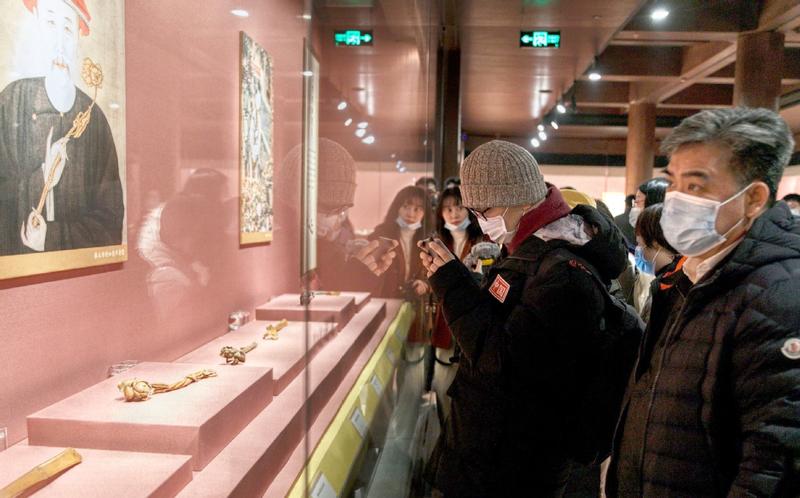 Journalists and guests visit the Auspicious Wishes: Ruyi Scepters in the Palace Museum Collection exhibition at the Palace Museum in Beijing on Feb 9, 2021. Various ruyi scepters are displayed in a cabinet, with a portrait on the wall of Emperor Yongzheng of the Qing Dynasty (1644-1911) holding a ruyi. (JIANG DONG / CHINA DAILY)
Journalists and guests visit the Auspicious Wishes: Ruyi Scepters in the Palace Museum Collection exhibition at the Palace Museum in Beijing on Feb 9, 2021. Various ruyi scepters are displayed in a cabinet, with a portrait on the wall of Emperor Yongzheng of the Qing Dynasty (1644-1911) holding a ruyi. (JIANG DONG / CHINA DAILY)
At Spring Festival, "jixiang ruyi" is a blessing you will hear all day. In Chinese, it means "wishing you auspicious times and that everything goes as hoped".
There are so many ruyi, a kind of decorative scepter, in a gallery at the Palace Museum in Beijing, also known as the Forbidden City, that it must be a place of extraordinarily good fortune.
The special three-month exhibition at the Shenwumen (Gate of Divine Prowess) Gallery-Auspicious Wishes: Ruyi Scepters in the Palace Museum Collection-will open to the public on Wednesday ahead of the Year of the Ox. It is the first major exhibition launched at the museum this year.
About 150 ruyi-made of wood, bamboo, gold, jade and other materials-have been selected for the exhibition from the approximately 2,000 such items in the Forbidden City's inventory. It was China's imperial palace from 1420 to 1911.
As a physical reflection of (Lunar) New Year blessings, ruyi will usher people to have a better understanding of our traditional culture for celebration.
Ren Wanping, Deputy director of the Palace Museum, Beijing
The decorative curved objects have long S-shaped handles, often with heads resembling clouds and lingzhi mushrooms, both auspicious totems in Chinese culture.
ALSO READ: Shenzhen exhibition spotlights passion for Chinese zodiac
"As a physical reflection of (Lunar) New Year blessings, ruyi will usher people to have a better understanding of our traditional culture for celebration," Ren Wanping, deputy director of the Palace Museum, said at a media preview of the exhibition on Tuesday.
"People have more and more mascots now, and the cultural significance of ruyi is gradually being forgotten by the general public in modern times," she said. "However, the beautiful wishes and the state-of-the-art craftsmanship they represent deserve to be inherited through the generations."
Ruyi used to be paw-shaped and were first used as back-scratchers in ancient China, according to Zhang Linjie, an associate researcher with the museum's department of objects and decorative arts. But they were widely admired by literati and became an indoor decoration in the Song Dynasty (960-1279).
They became indispensable royal amulets during the Ming (1368-1644) and Qing (1644-1911) dynasties, particularly on festivals, birthdays and weddings, as many were paid as tributes to the royal court from all over the country.
"Through the artifacts, people may have a glimpse of how the royal families celebrated Spring Festival during the imperial years," Zhang said.
One of the biggest Lunar New Year wishes that people may have is to beat the COVID-19 pandemic. Coincidentally or not, a new regular gallery will open at the museum on Wednesday showcasing 90 medicine-related cultural relics.
READ MORE: New Year traditions on hold
The gallery is in Yonghe Gong (the Palace of Eternal Harmony) on the eastern side of the Forbidden City.
From an exquisitely designed, 400-odd-year-old cabinet holding herbal medicines, documents and seals of the imperial hospitals, to handwritten prescriptions for curing emperors and empresses, the exhibition gives a panoramic view of how the medical system operated in the Forbidden City.
Some samples of Western medicines, medical equipment and even an anatomical microscope from the late Qing Dynasty showcase cross-cultural communication.
"Hopefully, this heritage can still contribute to the development of traditional Chinese medicine today," said Guan Xueling, a researcher with the museum's department of palace life and imperial ritual.
The fight against the ongoing pandemic is still having an impact on the Palace Museum. For example, to contain the spread of novel coronavirus, there will be a daily cap on the number of visitors to the ruyi exhibition.
Up to 5,000 people will be allowed in the gallery each day-3,000 in the morning and 2,000 in the afternoon-with all reservations made through the museum's online platforms.
Official statistics show there were just 3.58 million visits to the Palace Museum last year, a huge drop from the record-setting 19.3 million in 2019, due to the impact of COVID-19, which led to a 98-day closure of the museum and strict control of visitor numbers.
READ MORE: Livestream tour lets visitors peruse Palace Museum
However, the operators of the country's most-visited museum have kept looking for more ways to extend the reach of its collections during the holiday via cyberspace.
Since late January, online lectures on traditional Lunar New Year celebrations in China have been regularly released by the museum through its WeChat account.
More video clips, interactive games and online exhibitions featuring architecture, collections and the intangible cultural heritage of the Forbidden City will appear throughout the Spring Festival holiday.


